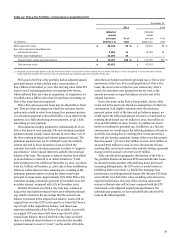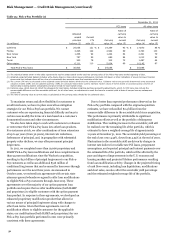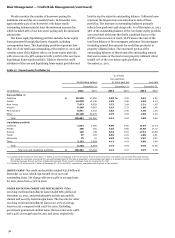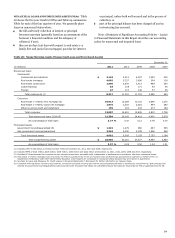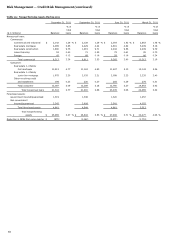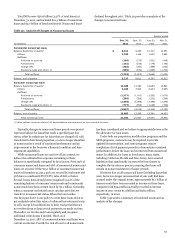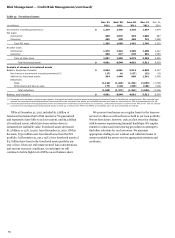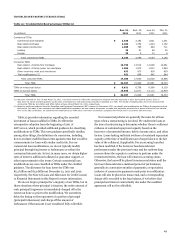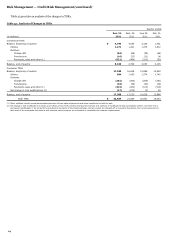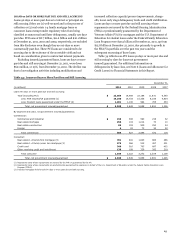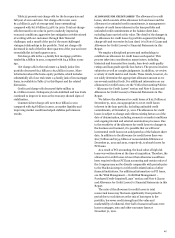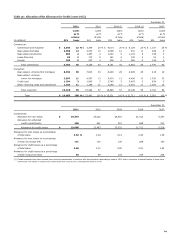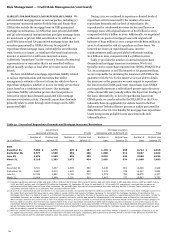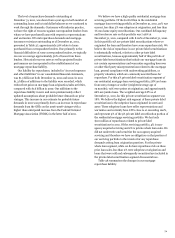Wells Fargo 2011 Annual Report Download - page 65
Download and view the complete annual report
Please find page 65 of the 2011 Wells Fargo annual report below. You can navigate through the pages in the report by either clicking on the pages listed below, or by using the keyword search tool below to find specific information within the annual report.
TROUBLED DEBT RESTRUCTURINGS (TDRs)
Table 32: Troubled Debt Restructurings (TDRs) (1)
Dec. 31,
Sept. 30,
June 30,
Mar. 31,
(in millions)
2011
2011
2011
2011
Commercial TDRs
Commercial and industrial
$
2,026
2,192
1,821
1,251
Real estate mortgage
2,262
1,752
1,444
1,152
Real estate construction
1,008
795
694
711
Leasing
33
51
84
25
Foreign
20
9
10
6
Total commercial TDRs
5,349
4,799
4,053
3,145
Consumer TDRs
Real estate 1-4 family first mortgage
13,799
13,512
12,938
12,261
Real estate 1-4 family junior lien mortgage
1,986
1,975
1,910
1,824
Other revolving credit and installment
872
875
838
859
Trial modifications (2)
651
668
942
944
Total consumer TDRs
17,308
17,030
16,628
15,888
Total TDRs
$
22,657
21,829
20,681
19,033
TDRs on nonaccrual status
$
6,811
6,758
6,568
6,129
TDRs on accrual status
15,846
15,071
14,113
12,904
Total TDRs
$
22,657
21,829
20,681
19,033
(1)
Amounts reported for June 30 and March 31, 2011, have been revised to reflect the retrospective adoption from the beginning of 2011 during third quarter 2011 of
ASU
2011-02, which provides guidance under what circumstances a restructured loan should be classified as a TDR. The impact of adopting ASU 2011-02 increased total
commercial TDRs by $1.5 billion and $793 million at June 30 and March 31, 2011, respectively.
(2)
Based on clarifying guidance from the Securities and Exchange Commission (SEC) received in December 2011, we classify trial modifications as TDRs at the beginning of the
trial period. For many of our consumer real estate modification programs, we may require a borrower to make trial payments ge
nerally for a period
of three to four months.
Prior to the SEC clarification, we classified trial modifications as TDRs once a borrower successfully completed the trial period in accordance with the terms.
Table 32 provides information regarding the recorded
investment of loans modified in TDRs. It reflects the
retrospective adoption from the beginning of 2011 of
ASU 2011-2, which provided additional guidance for classifying
modifications as TDRs. This new guidance specifically clarifies,
among other things, the definition of a concession, including
how to evaluate modified loan terms against terms that would be
commensurate for loans with similar credit risk. For our
commercial loan modifications, we do not typically modify
principal through forgiveness or forbearance or reduce the
contractual interest rate. In fact, in many cases, we obtain higher
rates of interest, additional collateral or guarantor support, or
other improvements to the terms. Certain commercial loan
modifications are now classified as TDRs under the clarified
guidance. The allowance for loan losses for TDRs was
$5.2 billion and $3.9 billion at December 31, 2011 and 2010,
respectively. See Note 6 (Loans and Allowance for Credit Losses)
to Financial Statements in this Report for more information.
We do not forgive principal for a majority of our TDRs, but in
those situations where principal is forgiven, the entire amount of
such principal forgiveness is immediately charged off to the
extent not done so prior to the modification. We sometimes
delay the timing on the repayment of a portion of principal
(principal forbearance) and charge off the amount of
forbearance if that amount is not considered fully collectible.
Our nonaccrual policies are generally the same for all loan
types when a restructuring is involved. We underwrite loans at
the time of restructuring to determine whether there is sufficient
evidence of sustained repayment capacity based on the
borrower’s documented income, debt to income ratios, and other
factors. Loans lacking sufficient evidence of sustained repayment
capacity at the time of modification are charged down to the fair
value of the collateral, if applicable. For an accruing loan that
has been modified, if the borrower has demonstrated
performance under the previous terms and the underwriting
process shows the capacity to continue to perform under the
restructured terms, the loan will remain in accruing status.
Otherwise, the loan will be placed in nonaccrual status until the
borrower demonstrates a sustained period of performance,
generally six consecutive months of payments, or equivalent,
inclusive of consecutive payments made prior to modification.
Loans will also be placed on nonaccrual, and a corresponding
charge-off is recorded to the loan balance, if we believe that
principal and interest contractually due under the modified
agreement will not be collectible.
63




